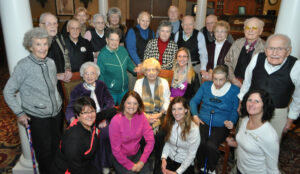For 45 minutes just about every day, Anne Grasha, 94, sits at a desk by her window at Country Meadows in Mechanicsburg and colors beautifully detailed cards to share with her friends and family. This is one of the times each day that she puts on her BalanceWear® vest.

Residents testing the BalanceWear vest enjoy a celebration with co-workers and inventor Cynthia Gibson-Horn (front, center in purple), and researcher Jennifer Vincenzo, (front center, in white.)
“I feel more comfortable wearing it,” says Grasha, “I like the way it feels and it makes me sit up straight.”
She began wearing the vest as a participant in the InVested Project—a six-month University of Arkansas and Motion Therapeutics research study conducted at Country Meadows of Hershey, West Shore and Ecumenical Retirement Community campuses last year. Researchers documented BalanceWear’s impact on balance and mobility for seniors who have non-neurological balance issues. (Read more about the study here.)
BalanceWear Vest inventor and Physical Therapist Cynthia Gibson-Horn and Researcher Jennifer Vincenzo, PT, MPH, Ph.D., report positive findings. Residents initially participating in the study showed an improvement in scores in some physical tests after just five days. After four months the results were even better with residents improving scores on their physical tests without canes or walkers even though they typically use those devices during regular activities.
At six months, the participants wearing BalanceWear improved five times more than the control group in the Short Physical Performance Battery test which measures walking speed, getting up and down from a chair and balance. Gibson-Horn notes that she’d like to do an additional study to see the impact of a tailored exercise prescription in conjunction with the BalanceWear.
“During the tests we measured balance during standing, walking activities, performing activities like get out of a chair, walking and turning your head just like you would if you were looking at something on a wall or talking to somebody or going into the grocery store while you’re walking,” notes Vincenzo. “Even something as simple as how fast you walk can predict you getting hospitalized, being sick, your mortality and risk for falls. Even if we improve just walking speed, that indicates that a person will be at a lower risk for all these factors.”
Country Meadows Executive Director of Fitness Kim Eichinger agrees that balance and worrying about a potential fall affects residents in different ways. “Becoming fearful of a fall can prevent a resident from participating in activities. They’ll say, ‘oh, I don’t want to go,’ because they are beginning to doubt their ability to take part, so it really affects their well-being. Loss of balance quickly becomes a quality of life issue.”
The BalanceWear vest works by providing light strategically placed counter-balancing weights to address a person’s unique balance losses. A series of simple physical tests determine the precise location for each weight to be attached with Velcro, inside the front and back of the vest. This is important because moving the weight by just an eighth of an inch can change its impact. Though benefits of BalanceWear vary, improvements have been seen in common challenges seniors can experience including balance, climbing stairs, ability to walk, speech, and vitality.
Horn compares how the vest works on balance to eyeglasses for vision. “Years ago when we didn’t have glasses, we had to suffer when we couldn’t see things. Then we got glasses and all of a sudden we could see things better,” notes Gibson-Horn. “This is just a different way of thinking of balance. You don’t necessarily have to use a walker because we can identify your imbalances and you can wear your balance.”
Grasha noticed an improvement just a few days into the study when she walked across a room without her cane and didn’t miss it. She recalls, “One day I realized I had walked across the room and had left my cane!”
In addition to helping validate the effectiveness of BalanceWear, Country Meadows participants helped to improve the vest’s design by providing suggestions on the vest’s design. Their feedback was used by manufacturer Motion Therapeutics to develop a vest that is easier to put on for older adults who have shoulder issues. Suggestions about the style and color of the vest also were submitted.
“I think participating in the study gave our residents a real sense of purpose. Their experiences and opinions have helped improve the product and they can feel good that their efforts are helping others as they continue to develop and improve the vests,” says Eichinger.
To meet demand of current BalanceWear users and new residents interested in trying the vest, Genesis Rehabilitation—Country Meadows’ and Ecumenical Retirement Community’s rehabilitation partner—has certified additional physical therapists to offer assessments considering the BalanceWear vest. With a doctor’s referral, any resident can begin the process of being test, fitted for and wearing the weighted vest.
Jim Mitchell, 98, participated in the study on the West Shore campus but then had some health issues and was unable to wear the vest. He is giving it another three month trial to see if it helps him improve his balance.
“I think it began to help; I think it gives me a little more balance,” he says.
Norman Fugitt, 87, who also participated in the study, says wearing the vest makes him feel better, and he doesn’t fall when he is wearing the vest.
“When I stopped wearing the vest, I got so I couldn’t get out of a chair, now that I’m wearing it again, that’s no problem. I have more stability, and I’m more confident wearing the vest,” he says.
Click here to view a video about the BalanceWear Vest In-Vested project.

